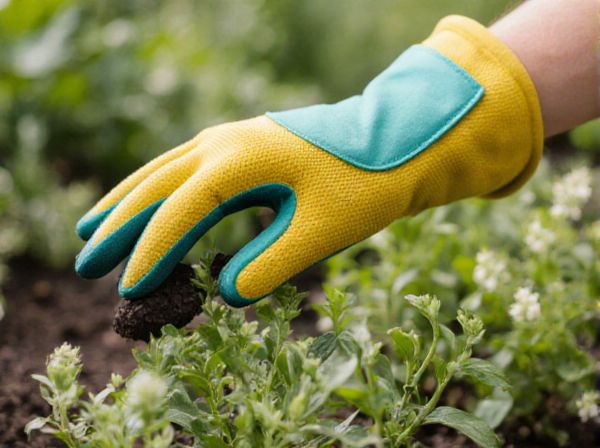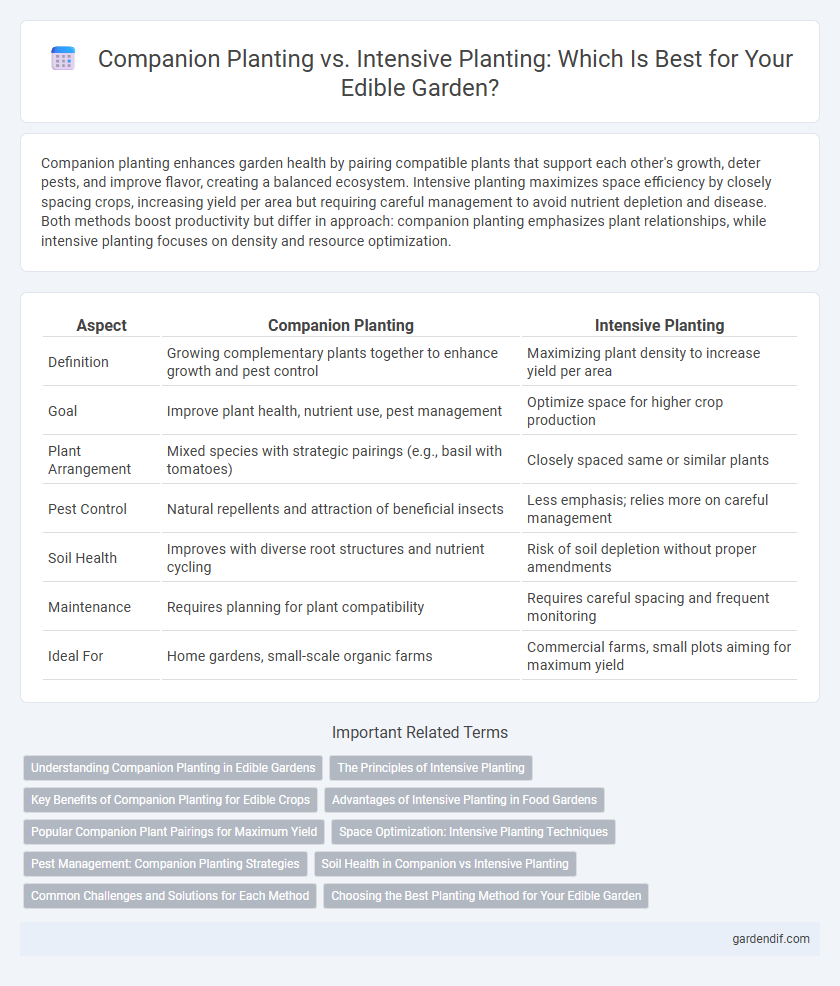
Companion Planting vs Intensive Planting Illustration
Companion planting enhances garden health by pairing compatible plants that support each other's growth, deter pests, and improve flavor, creating a balanced ecosystem. Intensive planting maximizes space efficiency by closely spacing crops, increasing yield per area but requiring careful management to avoid nutrient depletion and disease. Both methods boost productivity but differ in approach: companion planting emphasizes plant relationships, while intensive planting focuses on density and resource optimization.
Table of Comparison
| Aspect | Companion Planting | Intensive Planting |
|---|---|---|
| Definition | Growing complementary plants together to enhance growth and pest control | Maximizing plant density to increase yield per area |
| Goal | Improve plant health, nutrient use, pest management | Optimize space for higher crop production |
| Plant Arrangement | Mixed species with strategic pairings (e.g., basil with tomatoes) | Closely spaced same or similar plants |
| Pest Control | Natural repellents and attraction of beneficial insects | Less emphasis; relies more on careful management |
| Soil Health | Improves with diverse root structures and nutrient cycling | Risk of soil depletion without proper amendments |
| Maintenance | Requires planning for plant compatibility | Requires careful spacing and frequent monitoring |
| Ideal For | Home gardens, small-scale organic farms | Commercial farms, small plots aiming for maximum yield |
Understanding Companion Planting in Edible Gardens
Companion planting in edible gardens involves strategically placing plants to enhance growth, repel pests, or improve flavor through natural interactions. Unlike intensive planting, which maximizes space by densely planting crops, companion planting focuses on biodiversity and mutual benefits between specific plant species such as tomatoes with basil or carrots with onions. This method promotes healthier plants and reduces the need for chemical interventions, contributing to sustainable and productive edible gardens.
The Principles of Intensive Planting
Intensive planting maximizes crop yield within limited garden space by utilizing close spacing and efficient resource use, enhancing soil fertility and moisture retention. This method prioritizes plant health through optimized light exposure, air circulation, and nutrient distribution to reduce pest and disease incidence. Unlike companion planting, which focuses on plant compatibility, intensive planting emphasizes strategic density and crop diversity for sustainable productivity.
Key Benefits of Companion Planting for Edible Crops
Companion planting enhances edible crop yields by improving pest control through natural pest repellents and attracting beneficial insects, reducing the need for chemical pesticides. It promotes soil health by optimizing nutrient use and enhancing microbial activity, resulting in stronger, more resilient plants. This method also maximizes space efficiency by combining compatible species, increasing overall productivity in smaller garden areas.
Advantages of Intensive Planting in Food Gardens
Intensive planting maximizes space utilization by closely spacing crops, resulting in higher yields per square foot compared to companion planting. This method improves soil health through continuous ground cover, reducing erosion and moisture loss while suppressing weeds. Intensive planting also optimizes resource efficiency, including water and nutrients, leading to more productive and sustainable food gardens.
Popular Companion Plant Pairings for Maximum Yield
Popular companion plant pairings such as tomatoes with basil, carrots with onions, and beans with corn optimize space and boost crop yields by enhancing nutrient uptake and pest resistance. Intensive planting techniques combine with companion planting to maximize garden productivity by closely spacing complementary plants while reducing weed growth. Gardeners leveraging these pairings often experience increased harvests, improved soil health, and natural pest control.
Space Optimization: Intensive Planting Techniques
Intensive planting techniques maximize edible garden yields by closely spacing crops to optimize sunlight exposure and soil nutrients, reducing wasted space. Companion planting also benefits space optimization by pairing plants that mutually enhance growth and deter pests, but intensive planting focuses explicitly on high-density arrangements. Implementing row planting, square foot gardening, and succession planting enables gardeners to produce more food per square foot compared to traditional methods.
Pest Management: Companion Planting Strategies
Companion planting enhances pest management by utilizing strategic plant combinations that naturally repel harmful insects and attract beneficial predators, reducing the need for chemical pesticides. Plants such as marigolds deter nematodes and aphids, while basil repels mosquitoes and flies, creating a healthier growing environment. These ecological interactions promote sustainable agriculture by improving crop resilience and maintaining biodiversity within edible gardens.
Soil Health in Companion vs Intensive Planting
Companion planting enhances soil health by promoting biodiversity, which fosters beneficial microbial activity and natural pest control, reducing the need for chemical inputs. In contrast, intensive planting often depletes soil nutrients rapidly due to high crop density and limited crop rotation, necessitating more frequent fertilization. Maintaining soil organic matter and structure is more sustainable with companion planting, supporting long-term productivity and resilience.
Common Challenges and Solutions for Each Method
Companion planting often faces challenges such as selecting compatible plants that enhance growth without competing for resources, while managing pests naturally through beneficial plant relationships is a key solution. Intensive planting can lead to overcrowding and nutrient depletion, which requires careful soil management and regular pruning to maintain plant health. Both methods demand strategic planning to optimize space, maximize yield, and promote sustainable growth in edible gardens.
Choosing the Best Planting Method for Your Edible Garden
Companion planting enhances garden health by pairing compatible plants that improve growth, deter pests, and enrich soil nutrients, ideal for organic edible gardens seeking biodiversity. Intensive planting maximizes yield per square foot by closely spacing crops, optimizing sun exposure, and reducing weed growth, perfect for small or urban edible gardens aiming for efficient space use. Selecting the best method depends on garden size, soil fertility, pest management needs, and desired crop diversity to create a thriving edible garden tailored to specific conditions.
Companion Planting vs Intensive Planting Infographic

 gardendif.com
gardendif.com